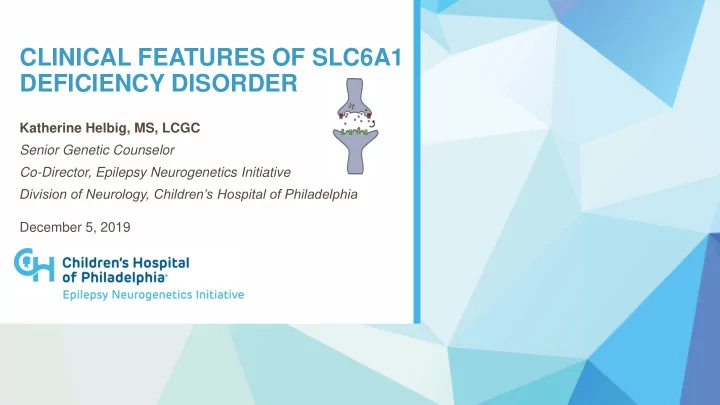

CLINICAL FEATURES OF SLC6A1 DEFICIENCY DISORDER Katherine Helbig, MS, LCGC Senior Genetic Counselor Co-Director, Epilepsy Neurogenetics Initiative Division of Neurology, Children’s Hospital of Philadelphia December 5, 2019
SLC6A1 GENE • Encodes instructions for GABA transporter 1 (GAT1) • Removes GABA from synaptic cleft Major inhibitory neurotransmitter in the brain GAT1 GABA 2 Credit: studyblue.com
SLC6A1 DEFICIENCY DISORDER • First implicated in neurological disease by Carvill et al. 2015 6 individuals with Epilepsy with Myoclonic-Atonic Seizures (MAE; Doose syndrome) with pathogenic SLC6A1 variants 4% of individuals with EMAS explained by SLC6A1 3
SLC6A1 DEFICIENCY DISORDER • Follow up study by Johannesen et al. 2018 4
SLC6A1 DEFICIENCY DISORDER • As of December 2019: >50 individuals published in the literature 70 unique SLC6A1 variants reported in HGMD 60 (likely) pathogenic SLC6A1 variants in ClinVar Phenotypic spectrum has expanded beyond Epilepsy with Myoclonic-Atonic Seizures (MAE/Doose syndrome) What does SLC6A1 Deficiency Disorder look like now? 5
PHENOTYPIC FEATURES: EPILEPSY • Epilepsy is present in 81% of individuals Median age of onset 24 months (range 5m – 7y) 65% of individuals become seizure free 5% 2%3% MAE 8% Generalized CAE 18% DEE 64% Eyelid myoclonia w/absence TLE 6
PHENOTYPIC FEATURES: EPILEPSY • Generalized seizure types predominate 60.0% Percentage of pts w/seizure type 50.0% 50.0% 44.1% 40.0% 29.4% 30.0% 20.6% 20.6% 20.0% 14.7% 8.8% 5.9% 10.0% 2.9% 0.0% Seizure types 7
PHENOTYPIC FEATURES: DEVELOPMENT • Developmental delays in 91% of individuals • No correlation between seizure control and developmental outcome 3% 9% 6% Age Appropriate Specific Learning Disability 35% Mild ID Moderate ID 47% Severe ID 8
OTHER NEUROLOGICAL FEATURES Aggression 11.8% Hypotonia 8.8% Ataxia/Tremor 29.4% ADHD 17.6% Autism/Autistic features 23.5% 0.0% 5.0% 10.0% 15.0% 20.0% 25.0% 30.0% 35.0% 9
SLC6A1 GENETIC SPECTRUM • 60 (likely) pathogenic variants reported in ClinVar • 70 variants reported in HGMD • Most commonly reported variant c.863C>T; p.(Ala288Val) 10
SLC6A1 GENETIC SPECTRUM Inheritance of SLC6A1 Variant Variant Type 3% 9% 10% Missense 16% de novo PTV Inherited (affected parent) 30% Splice 57% Inherited (unaffected In-Frame Deletion mosaic parent) 75% 12
TREATMENT OF SLC6A1 DEFICIENCY DISORDER • 65% of individuals become seizure free Developmental concerns unrelated to seizure control • Sodium valproate may be effective May not be specific to SLC6A1 Standard treatment for Epilepsy with Myoclonic-Atonic Seizures • Ketogenic diet? One published report (Palmer et al. 2016 Pediatr Neurol ) 13
HOW COMMON IS SLC6A1 DEFICIENCY DISORDER? • ~2% of all epilepsies in unselected cohort (Mattison et al. 2018 Epilepsia ) • 4% of all Epilepsy with Myoclonic-Atonic Seizures (Carvill et al. 2015 AJHG ) • 1.5% of adults with epilepsy and ID (Borlot et al. 2019 Epilepsia ) • ~1% of children with epilepsy onset <36 months (Symonds et al. 2019 Brain ) Prospective, population-based study 5th most common genetic diagnosis 8 children with EMAS (1 with SLC6A1 ) 14
GENOTYPE-PHENOTYPE CORRELATIONS? • Not explored in the published literature • Based on available data, no correlation between genotype and phenotype Systematic studies of genotype-phenotype correlations needed 15
SUMMARY • Childhood-onset generalized epilepsy in 80% Median onset 24 months Most common seizure types: absence (typical and atypical), atonic >60% Epilepsy with Myoclonic-Atonic Seizures (MAE, Doose syndrome) Seizures can usually be well-controlled (VPA, Ketogenic Diet) • Developmental delay in >90% Often apparent before seizure onset Most often mild to moderate developmental impairment • Ataxia and coordination difficulties in 30% • Autism spectrum disorders in 25% • No clear genotype-phenotype correlations 16
CHOP EPILEPSY NEUROGENETICS INITIATIVE TEAM Back Row Anne-Ashley Field, MS, OTR/L Ingo Helbig, MD Xilma Ortiz-Gonzalez, MD, PhD Holly Dubbs, MS, LCGC Ethan Goldberg, MD, PhD Colin Ellis, MD Mark Fitzgerald, MD, PhD Front Row Helen Milligan, MPT Eric Marsh, MD, PhD Katie Helbig, MS, LCGC Shavonne Massey, MD Sarah McKeown, MS, LCGC Contact: helbigk@email.chop.edu 17
Recommend
More recommend